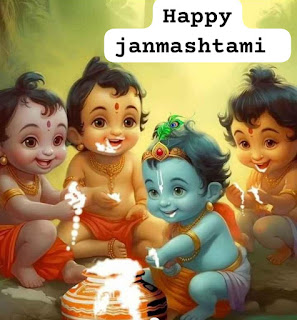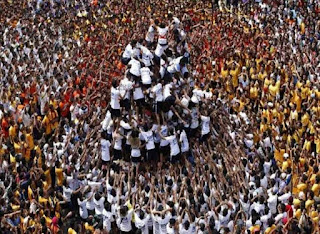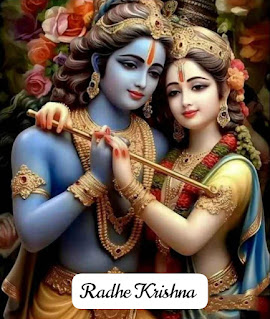Krishna Janmashtami or Gokulashtami information
Gokulashtami, also known as Krishna Janmashtami or simply Janmashtami, is a Hindu festival celebrated to commemorate the birth of Lord Krishna, who is considered the eighth incarnation of Lord Vishnu. This festival typically falls on the eighth day (Ashtami) of the Krishna Paksha (dark fortnight) in the Hindu calendar month of Bhadrapada, which usually corresponds to August or September in the Gregorian calendar.
 |
| Happy Janmashtami |
Here is some information about the celebration of Janmashtami or Gokulashtami:
- Date: The date of Gokulashtami varies each year based on the Hindu lunar calendar. It is celebrated with great enthusiasm and devotion by millions of Hindus across India and around the world.
- Significance: Gokulashtami is significant because it marks the birth of Lord Krishna, who is considered a divine figure, a symbol of love, and a source of wisdom and teachings in Hinduism.
- Preparations: People start preparing for this festival week in advance. Homes and temples are decorated with flowers, colorful rangoli patterns, and images of baby Krishna. Devotees fast on this day and break their fast at midnight when Lord Krishna is believed to have been born.
- Midnight Celebration: The main highlight of Gokulashtami is the midnight celebration when Lord Krishna is said to have been born. Devotees gather at temples and homes, singing bhajans (devotional songs) and performing dance dramas depicting the life of Lord Krishna. The idol of baby Krishna is placed in a cradle, and devotees swing it gently.
- Dahi Handi: In some regions of India, particularly in Maharashtra, a popular tradition called "Dahi Handi" takes place. Young men form human pyramids to reach and break a pot filled with curd or butter, which is tied at a height. This reenacts Krishna's childhood escapades of stealing butter.
- Fasting and Prayers: Devotees observe a day-long fast and visit temples to offer prayers to Lord Krishna. Many also read from the Bhagavad Gita, a sacred text that contains the teachings of Krishna to Arjuna.
- Feasting: After the midnight celebration, devotees break their fast by feasting on a variety of vegetarian dishes, sweets, and snacks. Some popular items prepared for Gokulashtami include laddoos, makhan (butter), and milk-based sweets.
- Cultural Performances: In addition to religious rituals, Gokulashtami is a time for cultural celebrations. Dance and music performances, dramas, and other cultural events are organized to honor Lord Krishna.
- Visiting Temples: Devotees visit Krishna temples, especially those dedicated to Lord Krishna's childhood (Bal Gopal), and offer prayers, flowers, and sweets.
- Devotional Songs and Bhajans: Throughout the day, people sing devotional songs and bhajans dedicated to Lord Krishna. These songs narrate the stories and teachings of Krishna.
According to Hindu mythology, Lord Krishna was born in Mathura to King Vasudeva and Queen Devaki. His birth took place in a prison cell, as his uncle, the tyrant King Kansa, had imprisoned his parents due to a prophecy that predicted that the eighth child of Devaki would be his downfall.
Symbol of Divine Love: Lord Krishna's life is filled with stories of his divine childhood, including his playful and mischievous activities as a baby, his endearing interactions with his foster mother Yashoda, and his youthful adventures with his friends and devotees. These stories symbolize the boundless love between the divine and the devotee.
Teachings and Wisdom: Lord Krishna's teachings, primarily found in the Bhagavad Gita (a sacred scripture within the Indian epic Mahabharata), provide profound insights into various aspects of life, duty, righteousness, and spirituality. His teachings on karma, dharma, and devotion continue to inspire and guide people in their spiritual journeys.
Universal Appeal: Lord Krishna's life and teachings have a universal appeal that transcends religious and cultural boundaries. He is seen as a symbol of love, compassion, and wisdom, making him a beloved figure not only among Hindus but also among people of various faiths and backgrounds.
Cultural Significance: Gokulashtami is celebrated with great enthusiasm and devotion in India and among the Indian diaspora worldwide. It is an occasion for families and communities to come together, observe religious rituals, sing devotional songs, and share in the joy of Krishna's birth.
Diverse Traditions: The celebration of Gokulashtami can vary from region to region and from one community to another. It incorporates a rich tapestry of customs, rituals, and festivities, including the midnight celebration of Krishna's birth, fasting, temple visits, and cultural performances.
In
essence, Janmashtami is celebrated to
honor and remember the divine birth of Lord Krishna, who is not only a
beloved deity but also a source of spiritual wisdom and inspiration. His life
and teachings continue to resonate with people, emphasizing the importance of
love, righteousness, and devotion on the path to spiritual realization and
inner peace.
"Dahi Handi" Celebration information
"Dahi Handi" is a traditional and popular ritual observed during the
celebration of Gokulashtami or Krishna Janmashtami in India, especially in the
state of Maharashtra and some other parts of the country. This ritual is a fun
and competitive activity that involves forming human pyramids to break a pot (Handi)
filled with curd or butter, which is hung at a considerable height. Here is
more information about Dahi Handi:
 |
| Dahi Handi Celebration |
- Origin: The tradition of Dahi Handi is inspired by the childhood antics of Lord Krishna. As the legend goes, Lord Krishna, known for his love of butter (makhan), would often steal it from hanging pots in the houses of his neighbors and friends. In honor of Krishna's playful and mischievous nature, Dahi Handi is celebrated.
- Date: Dahi Handi is most prominently observed on the second day of the Krishna Janmashtami festival, which is the day after Lord Krishna's birth. It is also known as "Govinda" or "Gopalakala.
- The Formation: To reenact Krishna's butter-stealing endeavors, young men, known as "Govindas" or "Govinda Pathaks," form human pyramids. The tallest person, often a young boy or man, climbs to the top of the pyramid and attempts to break the handi by hitting it with a blunt object like a stick or a coconut.
- The Handi: The handi is typically made of clay or an earthen pot. It is filled with a mixture of curd, butter, milk, and sometimes coins or other prizes. The handi is suspended from a rope or a pulley system, usually at a considerable height above the ground.
- Challenges and Prizes: Breaking the handi is not an easy task, as it requires careful coordination and teamwork. The person at the top of the pyramid has to balance and maintain their stability while attempting to break the handi. The onlookers often cheer and encourage the Govindas. In return for their efforts, the organizers of the event may offer prizes and rewards to the teams that successfully break the handi.
- Safety Measures: Due to the physical risks associated with forming human pyramids, safety precautions have become a significant concern in recent years. Many organizations and authorities now set regulations to ensure the safety of participants. Helmets, safety nets, and other protective measures are often put in place to prevent injuries.
- Competitions: Dahi Handi competitions are held in various cities and towns, and they draw large crowds. Teams from different areas compete to break the handi, with prizes and recognition awarded to the most successful and creative groups.
- Community Bonding: Dahi Handi is not just a ritual but also a community event that brings people together. It fosters a sense of unity, teamwork, and camaraderie among participants and spectators alike.
Dahi Handi is a vibrant and energetic tradition that adds a playful and competitive aspect to the celebration of Lord Krishna's birth during Krishna Janmashtami. It is a spectacle that captures the spirit of Krishna's childhood and continues to be a popular and cherished tradition in many parts of India.
 |
| Happy Gokulashtami |









0 Comments